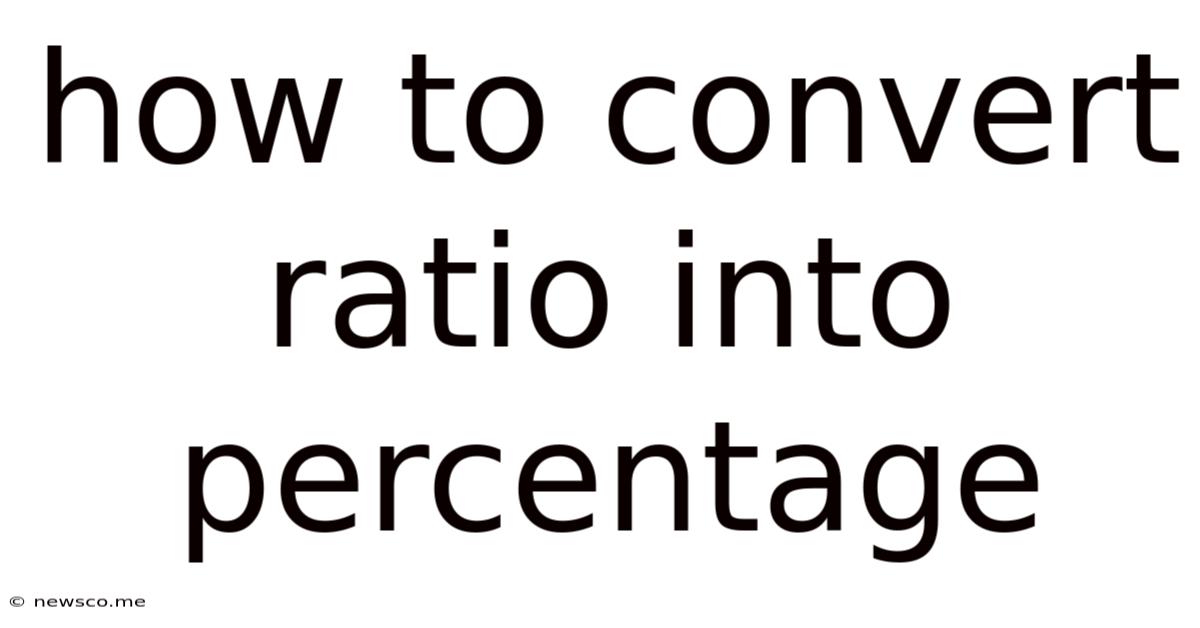How To Convert Ratio Into Percentage
News Co
Apr 02, 2025 · 4 min read

Table of Contents
How to Convert a Ratio to a Percentage: A Comprehensive Guide
Converting ratios to percentages is a fundamental skill with widespread applications in various fields, from finance and statistics to everyday life. Understanding this conversion process is crucial for interpreting data, making informed decisions, and effectively communicating quantitative information. This comprehensive guide will walk you through the steps, offer various examples, and explore different scenarios to solidify your understanding.
Understanding Ratios and Percentages
Before diving into the conversion process, let's refresh our understanding of ratios and percentages.
What is a Ratio?
A ratio is a mathematical comparison of two or more quantities. It shows the relative sizes of the quantities. Ratios can be expressed in several ways:
- Using the colon symbol: For example, 3:5 represents a ratio of 3 to 5.
- Using the word "to": This can be expressed as "3 to 5."
- As a fraction: The ratio 3:5 can also be written as 3/5.
What is a Percentage?
A percentage is a way of expressing a number as a fraction of 100. It indicates a proportion or rate per hundred. The symbol "%" represents percentage. For instance, 75% means 75 out of 100.
Converting Ratios to Percentages: The Step-by-Step Process
The core process involves transforming the ratio into a fraction and then converting that fraction into a percentage. Here's the breakdown:
Step 1: Express the Ratio as a Fraction
The first step involves representing the ratio as a fraction. If the ratio is already in fraction form, you can skip this step. For example:
- The ratio 3:5 becomes the fraction 3/5.
- The ratio 12 to 15 becomes the fraction 12/15.
- The ratio 1:4:2 becomes the fractions 1/7, 4/7, and 2/7 (after summing the parts 1+4+2=7). This shows the proportion of each part of the whole.
Step 2: Convert the Fraction to a Decimal
To convert the fraction to a decimal, simply divide the numerator (the top number) by the denominator (the bottom number). Using our example of 3/5:
3 ÷ 5 = 0.6
Step 3: Convert the Decimal to a Percentage
Multiply the decimal by 100 and add the percentage symbol (%). Continuing with our example:
0.6 x 100 = 60%
Therefore, the ratio 3:5 is equivalent to 60%.
Examples of Ratio to Percentage Conversion
Let's explore several examples to illustrate the process across different scenarios:
Example 1: Simple Ratio
Convert the ratio 2:8 into a percentage.
- Fraction: 2/8
- Decimal: 2 ÷ 8 = 0.25
- Percentage: 0.25 x 100 = 25%
Example 2: Ratio with Larger Numbers
Convert the ratio 15:25 into a percentage.
- Fraction: 15/25
- Decimal: 15 ÷ 25 = 0.6
- Percentage: 0.6 x 100 = 60%
Example 3: Ratio Involving Decimals
Convert the ratio 0.5:2 into a percentage.
- Fraction: 0.5/2
- Decimal: 0.5 ÷ 2 = 0.25
- Percentage: 0.25 x 100 = 25%
Example 4: Ratio with Three Parts
Imagine a company's market share is represented by the ratio 3:2:5 for Company A, Company B, and Company C, respectively. Calculate the percentage market share for each company.
- Total parts: 3 + 2 + 5 = 10
- Fractions:
- Company A: 3/10
- Company B: 2/10
- Company C: 5/10
- Decimals & Percentages:
- Company A: (3 ÷ 10) x 100 = 30%
- Company B: (2 ÷ 10) x 100 = 20%
- Company C: (5 ÷ 10) x 100 = 50%
Simplifying Ratios Before Conversion
Simplifying a ratio before conversion can make the calculation easier. If the numerator and denominator share a common factor, divide both by that factor to simplify the fraction. For example:
The ratio 12:18 can be simplified to 2:3 by dividing both numbers by 6. Then:
- Fraction: 2/3
- Decimal: 2 ÷ 3 ≈ 0.6667
- Percentage: 0.6667 x 100 ≈ 66.67%
Simplifying first avoids working with larger numbers and reduces the risk of calculation errors.
Handling Ratios with More Than Two Parts
When dealing with ratios containing more than two numbers, the process involves determining the total number of parts and calculating the percentage of each part relative to the whole. Refer back to Example 4 for a detailed illustration of this scenario. Remember to treat each component as a fraction of the total.
Applications of Ratio to Percentage Conversion
The ability to convert ratios to percentages is vital in numerous contexts:
- Financial Analysis: Determining profit margins, return on investment (ROI), and debt-to-equity ratios.
- Statistical Analysis: Interpreting survey results, analyzing data distributions, and presenting findings effectively.
- Business Management: Assessing market share, employee performance, and resource allocation.
- Everyday Life: Calculating discounts, tips, and proportions in recipes.
Conclusion
Converting ratios to percentages is a straightforward process that empowers you to interpret data more meaningfully. This guide has provided a detailed step-by-step approach, along with illustrative examples and practical applications. By mastering this skill, you’ll enhance your ability to analyze information, solve problems, and communicate quantitative data effectively across various domains. Remember to simplify ratios whenever possible to make the conversion process smoother and less error-prone. Practice regularly to build fluency and confidence in this essential mathematical skill.
Latest Posts
Related Post
Thank you for visiting our website which covers about How To Convert Ratio Into Percentage . We hope the information provided has been useful to you. Feel free to contact us if you have any questions or need further assistance. See you next time and don't miss to bookmark.